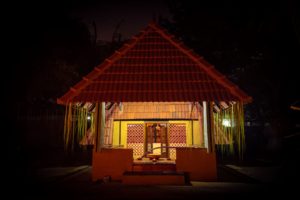
Bodhi Vana at Visthar is conceived as a sacred grove. Sacred groves are spaces that protect and preserve rare fauna and flora that the Earth can return to regenerate Herself. It is the primal storehouse of Life. The Bodhi Vana is designed as a place for reflection inspired by the ecological meanings of the sacred groves.
The first saplings, in this space, were planted in 2004 with the advice received from Dr. A.N Yellappareddy, the renowned conservator of natural forest. We planted Peepal and Banyan trees, Bilva patra, Amla, Fig, and Neem. We planted and left them to their own. After that, we were preoccupied with many other things, but those tender and vulnerable saplings kept growing, and you can see now how big they have become. It was like our mothers at home who put some curd in the milk before going to bed in the night. Morning when we are up, the whole milk would have turned into wonderful curd.
David, Mercy and I spent some time here in early February thinking of purposing this space, as space also for reflection on sacred space. To purpose a reflection we have inter connected these trees and space with a dry well, lily pond and a small architectural space using a winding wall. As you enter the Bodhi Vana, to your right is the old dry well, lost its meaning and once abandoned, but for the last 17 years has been repurposed as a well of regeneration. The dry well is a witness to our flawed developmental aspirations. As an extension of the form of the well is the circular wall. Sections of this wall are made out of materials that are segregated and discarded.
So the natural question to ourselves would be why and when do we segregate or discard something? We do that when we find it has no ‘Use Value’. Our use value may come from mere immediate existential needs, from the view of comfort, understanding of beauty, or even that help achieving our dream goals. Anything comes in its way we tend to discard. All what we select and keep are that fit into our needs. Our need is limited to our knowledge of things and our knowledge of things is limited to our immediate needs. Frightening it is, we do not hesitate to maintain the scope of the world to our limited knowledge of things, to our understanding of needs. So without speaking, this wall speak about the discarded and martyrs of our times. Hence this wall that is made of segregated and discarded, called Martyrs Wall, symbolically represents all those who are thrown out of our vicinity and have become martyrs.
A good architect takes into consideration the land, the rocks, the trees, slops etc., to make it integral part of his design, a bad architect will flatten the land to execute his studio based design. A bad farmer removes all the trees, shrubs etc. to develop his mono-culture farm. Whereas a good farmer would keep most, she sees the meaning of most things to everything else grown in her land.
When the Nations started dreaming to develop itself focusing only on economy, from time to time certain people, communities or land get segregated or discarded. As some of us in the process get segregated and discarded, we too with our limited thinking, desire for efficiency, or achieving our dreams discard some other systems. Once we discarded tribal. Now farmers are discarded in the minds of our economists who make decisions for our nation. With which we are not discarding merely people but also our choices of common survival. Because Agriculture is not a technical activity of applying science to food production but rather a socio-cultural practice, rich with deep rooted meanings for the people involved. Agriculture is farming and farming is responsible keeping, breeding, and rearing. It is soil, seed, moisture, warmth, air, vulnerability, and also pests, weeds, and affection. It is observation and staying alert, it is people and relationships. Industrial agriculture is the antonym of it.
So if engaged with the discarded will help open us to the intelligence and inner working of the small, the insignificant, the formless – the things at the edges and that are out of our vicinity. They all are to come alive in our consciousness, as fundamental life forces playing vital roles to sustain earth and life.
The architectural space at Bodhi Vana is an intimate small space, a pyramidal structure from four feet below the earth pointing to the sky. It connects earth and sky like a tree. The space invites you to sit, to sit in the company co-seekers, to heal ourselves and the suffering Earth. To regenerate the earth and us within the meaning and glory of mutual fecundity.
It is time for us to start preserving small patches of land, as Devara Kadu, and communities that hold wisdom for our common survival, not remaining limited to our knowledge, but to learn to regard, honor and celebrate, hence we can return to when our own knowledge and dreams betray us.
And equally beautiful would be if we too can be like the sacred groves, to which humanity can return to when they are wounded and suffering.
C.F. John



